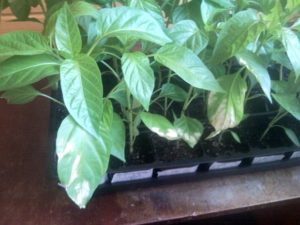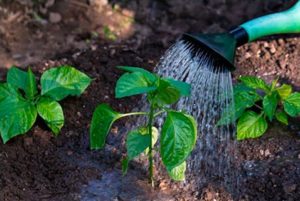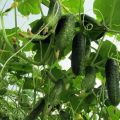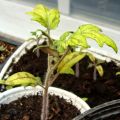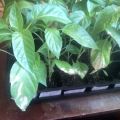The reasons why pepper leaves turn yellow, fall off and dry out, what to do
When pepper leaves turn yellow, you need to know why this is happening. Only in this case can the situation be corrected and the harvest saved. There can be many reasons.
The most common are improper care, disease or pest infestations.
Reasons for color change
There are several reasons for the yellowing of the leaves of peppers planted in a garden plot.
- Improper watering. Bell pepper has a very delicate and vulnerable root system, so the plant reacts strongly to a lack of moisture or, conversely, excessive watering. Wet soil leads to rotting first of the roots, then the upper part. Lack of moisture causes the leaves to dry out.
- Watering with cold water that has not settled down stops the development of the plant. If the water for irrigation is regularly cold, a real leaf fall is observed.
- Sharp temperature fluctuations. Leaves turn yellow, both from the cold and from direct sunlight. This is especially true for young seedlings. Therefore, you need to take care of shading on a hot day and cover during frost.
- For the pepper, you need to find the right place on the site in the open field. You cannot plant where tomatoes, potatoes, eggplants used to grow. The residual roots of these plants begin to secrete substances that harm the development of the pepper. In place of nightshade vegetables, you need to plant no earlier than three years later. Otherwise, the pepper sheds its leaves and disease resistance decreases.
- Deficiency of nutrients. First of all, the condition is affected by a lack of nitrogen. First, the upper leaves brighten, and then begin to turn yellow from the middle. At the same time, the fruits have thin walls and curl. If the lower leaves turn yellow, there may be a lack of potassium. At the same time, the tips of the leaves dry, the trunk changes color, becomes hard, spots appear on the fruits. With a zinc deficiency, yellow-green spots can be found on greens. It is quite possible to correct the situation or prevent problems with timely feeding.
- Pepper leaves fall off and change color due to insects. All vegetable growers face pests. Most often, pepper attacks spider mites. It feeds on the sap of the foliage, which causes yellowing and drying out. Soon, if you do not take action, the edges of the leaves will begin to dry, and then not only they, but also the fruits may completely fall off. Any insecticide, for example, Fitoverm, Aktara, or a self-made solution based on wood ash, bird droppings, green grass and other components, helps from pests.
- It happens that the leaves of peppers turn yellow from diseases and what to do in this case, you must definitely know. If the plant is infected with a virus, the leaves begin to turn yellow and dry, the fruits bend.To save the entire bed, it is necessary to urgently remove the infected plant, and treat the soil with a disinfectant solution, for example with potassium permanganate.
- Lack of sunlight leads to yellowed foliage. Often the problem appears when the bushes are planted in a shaded area.

It is important for preventive purposes to treat the plant from pests and diseases, apply fertilizers at least three times during the entire growing season, prevent weeds in the garden and recognize in time why the yellow leaves of the pepper have become, so as not to ruin the entire crop.
Sometimes a yellow leaf at the bottom of the stem appears as a result of maturation and growth of the vegetable. At the same time, all other parts of the bush look good.
The problem with young seedlings in a greenhouse
It is recommended to grow seedlings of peppers in a greenhouse. First, you need to dig up the soil, get rid of weeds, treat pests and apply organic or mineral fertilizing.
Many vegetable growers are worried about the problem, why does the foliage of sweet peppers turn yellow even in favorable greenhouse conditions? To understand what is happening to a plant, you need to monitor its growth and development at every stage.
Pepper seedlings cannot be protected from various misfortunes, even in a seemingly protected place like a greenhouse. There are several reasons why the leaves of the seedlings turn yellow and ultimately fall off completely.
- Irregular watering can be the cause of leaf fall in a greenhouse plant. It is not recommended to allow the soil to dry out. During a drought, the seedlings wither, and a yellowish tint appears on the greenery. It is recommended to water young seedlings with settled water once every five days.
- Too frequent soil moisture is also harmful. With an excess of moisture, the lower leaves of the seedlings fall off.
- Lack of nitrogen, potassium or phosphorus in the soil.
- The air temperature in the greenhouse should not fall below 14 degrees. Otherwise, the soil freezes, and the lower leaves of pepper seedlings turn yellow. If the temperature does not return to normal, the whole plant dies.
- Peppers react to a drop in air humidity. A moisture indicator of 70% is considered normal.
- Insufficient light supply leads to the fact that the leaves dry and crumble. A month after planting the seeds, the seedlings need to provide additional lighting.
- Why seedlings have leaves in poor condition also depends on the distance at which the seeds are sown. If the seedlings are nearby, the roots and leaves begin to interfere with each other, intertwine. As a result, the stems stretch out and the foliage turns yellow.
- A plant can shed leaves due to the vigorous activity of insect pests. If pests are the cause, they can be easily noticed. The most common are aphids, thrips, spider mites.
- When the leaves of the pepper turn yellow and even fall off, often the cause is a fungal, viral or bacterial disease.
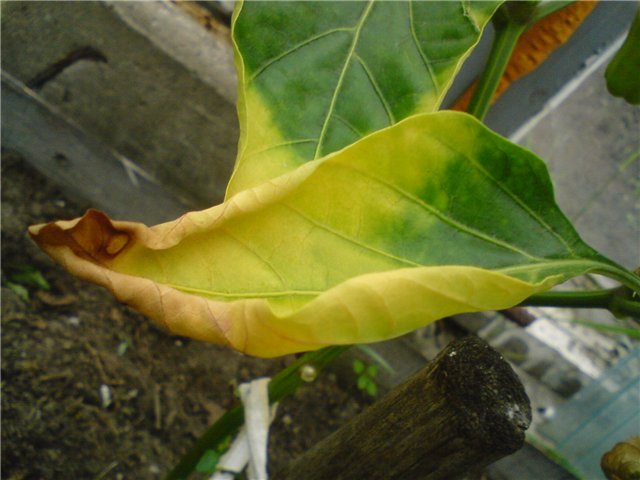
Proper seedling care begins with the selection of seeds for planting. You need to choose only large and dense grains. Then they must be kept for some time in a solution of potassium permanganate so that no bacteria remain on the shell of the seeds.
The first fertilizer for seedlings should be done when two leaves appear. Then you need to wait for the 6 leaves to unfold. An infusion of manure or poultry droppings is suitable as organic dressings. Fresh manure should not be applied to the soil, as this can lead to a burn of the plant's root system. From mineral fertilizers, potassium-phosphate elements are required.
Growing seedlings at home
When the seedlings are grown at home, on the windowsill, then one cannot avoid problems even here. If the pepper seedlings have turned yellow, you need to deal with the reason in time in order to get a rich harvest in the future.

Why does the color and condition of the seedlings change? If the leaves of all pepper seedlings turn yellow, you need to calculate the root cause to help restore the plant.
- Seedlings turn yellow due to a weak root system. In young seedlings, the roots are the weakest part, it is their damage or strong growth that causes yellowness. Roots become tangled and intertwined, nutrients are poorly distributed, and roots die off. The roots can also be damaged during deep loosening. It is recommended to carefully dig the plant out of the container and check the roots. If there are few root branches and they have darkened, the plant dies. If the roots are intertwined, but the white ones need to be carefully straightened.
- When everything is in order with the root system, the reason may be due to a nitrogen deficiency. It is recommended to apply nitrogen-containing fertilizers, you can use urea or ammonium nitrate. But don't overdo it. Since an excess of nitrogen also affects the condition of the plant. Fertilizers should be applied at intervals of two weeks.
- Sometimes the answer to the question of why the leaves fall and turn yellow is associated with a decrease in the air temperature in the room. Young seedlings do not tolerate temperatures below 14 degrees. The box with seedlings should not be placed in a draft.
- The reason for the leaves falling off may be due to incorrect dosing of water. Freshly planted seedlings are watered once every 5 days, as soon as the sprouts gain strength, watering is increased to once every three days. Do not neglect these rules, as an excess or lack of moisture can affect the fact that the pepper leaves begin to turn yellow and fall off.
- Insufficient light supply can lead to blanching leaves and stretching of stems. Therefore, the seedlings are best placed on the windowsill of the south window. On short or cloudy days, additional lighting should be provided.
Seedlings need to be transplanted to a permanent place on time. If it outgrows, then the roots will be large and in the new free place they will begin to diverge even more to the sides. All nutrients and strengths will go to their development, and not to the top. As a result, the pepper does not grow, and the leaves dry out.
